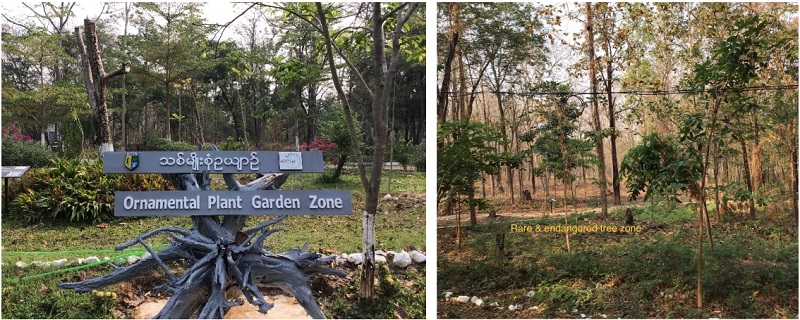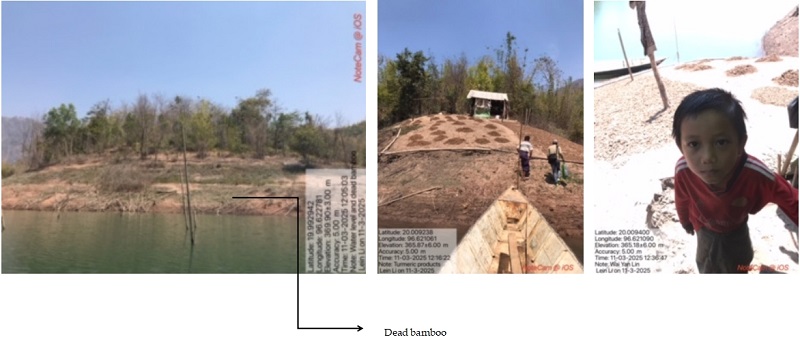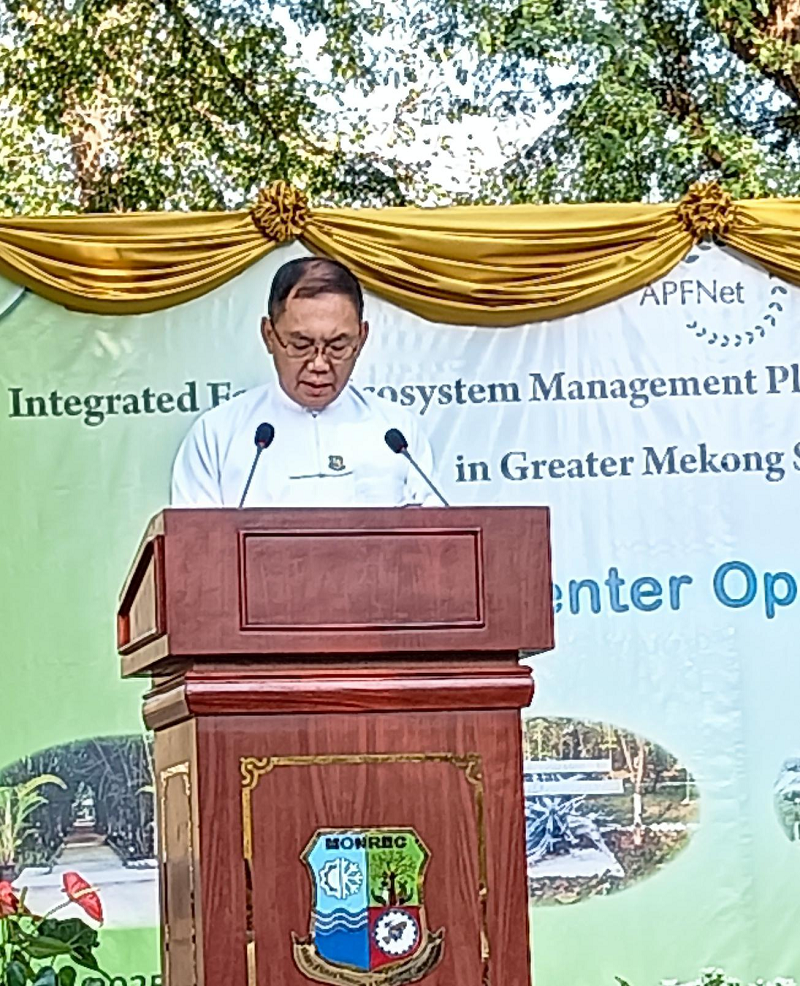Background
Myanmar is one of the most forested economies in the Greater Mekong Subregion, with its diverse tropical and subtropical monsoon forests serving as vital habitats for rare species and a critical source of timber and non-timber forest products supporting local livelihoods. Since 1995, the Myanmar government has promoted sustainable forest resource development to balance ecological integrity with economic growth. However, unsustainable practices such as charcoal production, shifting cultivation, and encroachment have severely degraded forest ecosystems, leading to the loss of forest genetic resources and threatening over 80 species listed on the IUCN Red List. Therefore, restoring their natural habitats through in-situ conservation is essential while ensuring ex-situ conservation as a safeguard. Under this scenario, this APFNet-funded “Integrated Forest Ecosystem Management Planning and Demonstration Project in Greater Mekong Sub-region (Myanmar site)” addresses these challenges by establishing a botanical garden for ex-situ conservation of threatened genetic resources and implementing integrated watershed forest management in the Paung Laung watershed to restore ecosystem services through in situ approaches. The project was implemented over five years (from October 2019 to October 2023, then extended to October 2024), with a total budget of USD 141.24 million, including USD 112.08 million funded by APFNet.
The project’s most distinctive feature lies in its integrated approach that combines ex-situ and in-situ conservation, forest protection and sustainable use, thus effectively advancing sustainable forestry development in Myanmar.
Upon the completion of this project, a grand Project Completion Workshop and the Opening Ceremony of the Education Centre at the arboretum were held in the Forest Research Institute (FRI) to witness this milestone. Representatives from the Ministry of Natural Resources and Environmental Conservation, the Forest Research Institute (FRI), the APFNet Secretariat, the evaluator and community farmers involved in the project were invited to attend the events. Following the ceremonies, the evaluator conducted the project terminal evaluation.

Figure 1. Opening Ceremony of the Education Centre at arboretum (Photo by project Staff, FRI, 2025)
Figure 2. Panoramic diorama of the arboretum (Photo by project Staff, FRI, 2025)

Figure 3. Exhibition of Rare Tree Species Seed Resources (Photo by project Staff, FRI, 2025)
Figure 4. Exhibition of High-Value Timber Species (Photo by project Staff, FRI, 2025)
Key findings of the terminal evaluation by an independent consultant
The terminal evaluation confirmed that the project achieved its intended goals with all planned activities completed and expected outputs delivered efficiently, except for the slight change of replacing the international expert’s field visit with a wetland innovation activity.
The arboretum was established in the FRI compound, and the existing nursery with 50,000 seedlings was upgraded to 100,000. Fifty different germplasm resources were collected, a greenhouse was built to accommodate the collected germplasm resources (species), and they grow well in the greenhouse. About 1,000 seedlings of each species have been raised. Five thousand seedlings were distributed to local farmers from Leinli village to plant in the agroforestry demonstration plots in 2022. Some 3000 seedlings were distributed to local forest farmers from Chaung Mange village for agroforestry development. The remaining seedlings are kept in the nursery for genetic conservation.
A 9-ha native forest ecological conservation zone was established in the FRI compound, 900 native species of teak, Tamalan and Pyinkado have been planted, and conservation activities of fire protection, weeding, climber cutting and cleaning in the rainy season, gap planting with Pyinkado, Yinma in the gap spaces were done. The trees in this zone provide seeds every year to produce seedlings. During the field evaluation, the girth at breast height of a Dipterocarp species was measured and recorded at 5 feet 7 inches (approximately 55 cm in diameter), indicating healthy growth. Several other tree species at the site, including Pyinkado, Thinwin, Yinma, Tamalan, Sit, Sandalwood, Nabe, and Bantbwe, also demonstrated good growth performance and species diversification.

Figure 5. Measuring the Dipterocarp tree in nature conservation zone. (Photo by project Staff, FRI, 2025)
Figure 6. A wooden bridge to facilitate easy passage for visitors in medicinal garden (Dimension at length 9 m x width 1.8 m (Photo, FRI)
16 ha Thematic gardens were established, including a 3-ha bamboo garden, a 3-ha ornamental garden, a 3-ha medicinal plant garden, a 2-ha rare and endangered tree species garden, a 2-ha fruit tree garden, a 2-ha precious timber tree garden, and a 2-ha aquatic garden. It’s found that the site selection for ornamental trees, herbal plants, rare and endangered tree species, fruit trees, and precious timber trees is well-matched, and the plants are growing well. These plants receive comprehensive care, including weeding, pruning, and fire prevention during the hot season, ensuring survival. Accessory facilities, such as entrances, roads, and irrigation systems, were also constructed. Now, the FRI as EA is responsible for maintaining these gardens, such as fire protection, regular watering, pest and disease management, and preventing illicit cutting, in perpetuity to ensure their sustainability.

Figure 7 Ornamental Garden zone (Photo by San Win, 2025)
Figure 8 Thai Pyinkado (Sindora siamensis) is growing well in new place (Photo by San Win, 2025)
The tree identification system has been completed, and identification bar codes for 227 species have been fully implemented at the FRI. The species bar codes, displaying the species name in the local language, the scientific name, and the associated bar code, are indicated on boards placed at the base of the trees. With 240 trees now barcoded, visitors can easily access detailed information about each tree, including its distribution, scientific name, common name, geo-reference, and usage, via the website.

Figure 9 An exotic bamboo (from Indonesia) (right) and a native tree (Thin Win) barcoded (Photo by San Win, 2025)
Best Practices of demonstration of integrated watershed management practices in Lein Li Village
Timber trees of Padakuk (Pterocarpus macrocarpus), Thin-win (Millettia pendula), fruit tree species such as Chin-danyin (Parkia speciose), Jack fruit (Artocarpus heterophyllus) and Bamboo (Wabo; Dendrocalamus giganteus) are matched to the present agroforestry farm areas. Accordingly, the trees, plants and bamboo are thriving well.
A 36-ha fruit tree plantation was established. Perennial fruit trees and seasonal crops were planted, and seasonal crops were intercropped between lines of timber trees.

Figure 10 A jackfruit tree (right photo) is now yielding large fruits in a project participating farmer’s agroforestry plot. The middle image shows a pineapple yielding fruit. The farmer’s name is U Mg Aye. The left photo shows the mixed cropping of timber tree (Padauk) and Jackfruit. (Photo by San Win, 2025).
Note: Padauk (Pterocarpus macrocarpus) is a deciduous tree species, and in summer, it sheds its leaves, meaning there are no leaves.
The project team found that the selected perennial food trees, such as Jackfruit, are well-suited to the current site, and both the Jackfruit and pineapples are now bearing fruit. However, during the Yagi storm in September 2024, the planted bamboos were unfortunately submerged and destroyed by flooding, as depicted in the accompanying photo.

Figure 11. The impact of severe flooding is evident in this photo. Debris is dead bamboo. (Photo by San Win, 2025)
Figure 12 Farmers dry their harvested turmeric through solar rays, and a child protects his parents’ turmeric business (Photo by San Win, 2025).
Training courses for young researchers, local officials and local leaders on integrated forest management technology and rehabilitation of degraded forests and training courses for local farmers (80-100 trainees) on tree seedling raising, planting, agroforestry, organic farming, maintenance of fruit orchard and tree plantation, fruit processing and marketing were conducted.
Lessons Learned
When establishing a garden with diverse plant species, it is essential to prioritise the local environment. Plants thrive in varying conditions such as temperature, elevation, soil types, and water availability, all of which must be carefully considered. In a location like FRI, Yezin, situated in central Myanmar with a predominantly hot climate, collecting a wide variety of plant species and undertaking diligent tending operations to ensure high survival rates is necessary. These operations are costly and labour-intensive, highlighting the importance of strategic planning and resource allocation for successful garden establishment, which the project team should consider for long-term success in organising a herbarium.
Recommendations
The project team should prioritise the greenhouse’s solar-powered electrification to maintain the cooler temperatures required for plant survival. Introducing entrance fees for the arboretum and greenhouse early could help generate funds to support this need.
The tree identification system relies on a stable internet connection, which limits its functionality in areas with poor connectivity, highlighting the need for improved accessibility.
Follow-up activities should include fire protection, bush cutting, coffee planting as an

According to Mr. H. E. U Khing Maung Yi, Union Minister of the Ministry of Natural Resources and Environmental Conservation of Myanmar during the Opening Ceremony of the Education Center at the arboretum in Yezin, Nay Pyi Taw in 2025, “This project represents a pivotal step forward to promote sustainable development in Myanmar. The establishment of arboretum is a groundbreaking initiative for Myanmar as it provides a unique platform for local university students and Forest Department personnel to enhance their understanding of biodiversity and plant genetics. By bringing together both in-situ and ex-situ plant conservation in one location, the arboretum serves as a living classroom for hands-on learning and research. Education is the cornerstone of sustainable development, and this facility will empower future generations to become responsible stewards of our natural resources.In addition to its educational impact, the project has made substantial progress in promoting integrated watershed management. Demonstration activities,including the inter-planting of timber species, fruit trees, and bamboo along site boundaries,have been implemented across a total area of 118 acres.Furthermore, this project has organized 14 training sessions for young researchers, local government officials, and farmers, focusing on integrated forest management technologies and approaches to rehabilitate degraded forests. These efforts are helping to build local capacity and ensure the long-term sustainability of forest landscapes in Myanmar.” His remarks underscored how the project has addressed critical gaps in environmental education and local capacity for sustainable forest management in Myanmar. By establishing a multifunctional arboretum and delivering hands-on training, the project has strengthened both conservation knowledge and practical skills to restore degraded forest landscapes.
under-canopy for the established tree crops, and watering using solar-powered water pumping systems. Additionally, supporting participating farmers in marketing their products is essential. These actions will help ensure the long-term sustainability of the demonstration farms.
Impact
Now the 16-ha thematic gardens have become a good scientific site and a favourite place for recreation; the University students of University of Forestry and Environmental Science (UFES), Yezin Agricultural University (YAU) and the University of Veterinary and Animal Science (UVAS), and the local people in the vicinity of FRI have now significant opportunities for studying diverse species of plants, the plants usefulness, their performances and so on in FRI, and for life-long learners, and visitors for recreation.
The tree identification system represents a significant advancement in efficiently classifying trees, shrubs, and herbs by their habitat, uses, morphology, and other traits, reflecting the project’s innovative approach.
The local farmers participating in the demonstration of integrated watershed management practices in Lein Li Village have been equipped with the tools to raise forestry nurseries systematically, how to handle the saplings before transplanting to the sites, and when is best for transplanting.
Before the project implementation, the participating villagers were accustomed to clearing forests through fire burning for crop growing. Now, they have the skills to establish an agroforestry farm using the zero-burning method. Most importantly, they now have an economic asset, an agroforestry farm full of commercially important tree species and perennial fruit trees.
Having experienced the devastating impacts of the Yagi storms and heavy thunderstorms in late September 2024, the participating villagers have come to recognise the critical role of trees and healthy watersheds in mitigating the effects of extreme weather. These events served as a wake-up call, reinforcing the value of forest conservation to protect their environment and livelihoods.
The project objectives and activities are highly aligned with international forestry goals (such as SDGs 1, 2, 6, 13, 14, and 15), Myanmar’s national forestry policies(Myanmar Reforestation and Rehabilitation Programme (MRRP), National Forestry Master Plan (2001-02 to 2030-31), National Watershed Management Policy and the Community Forestry Instruction (CFI, 2019) ), and APFNet’s priority areas, thus guaranteeing the sustainability of the project.
For more about the projects, please see https://www.apfnet.cn/column295/column302/1118.html